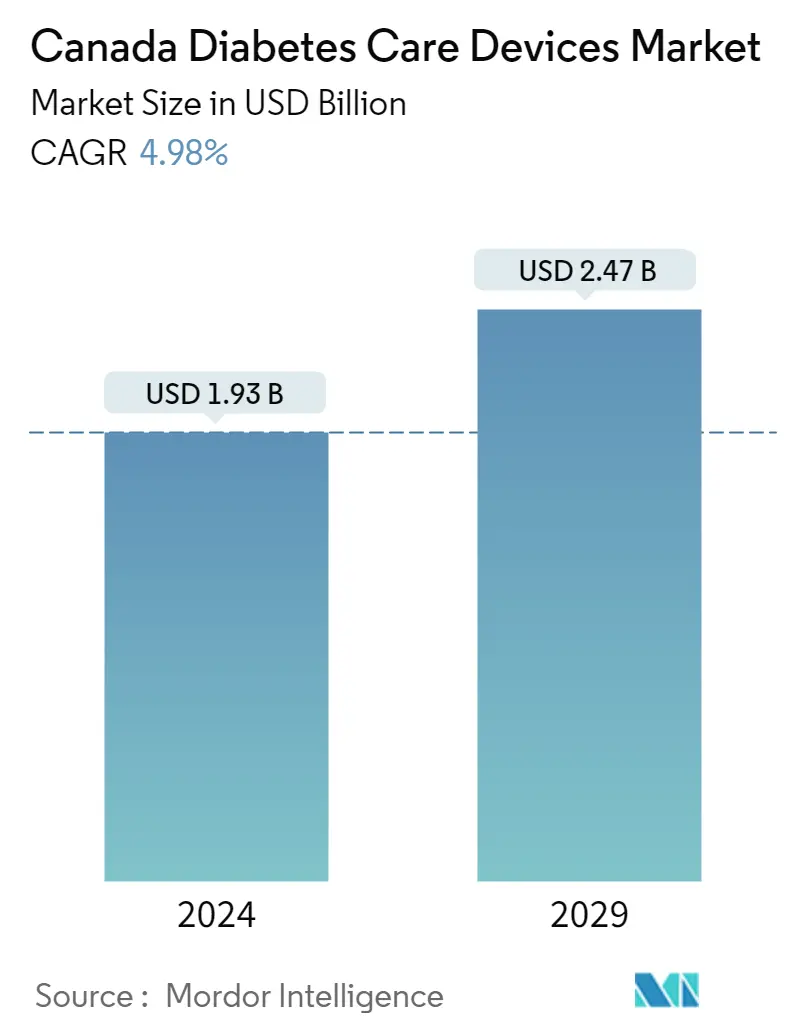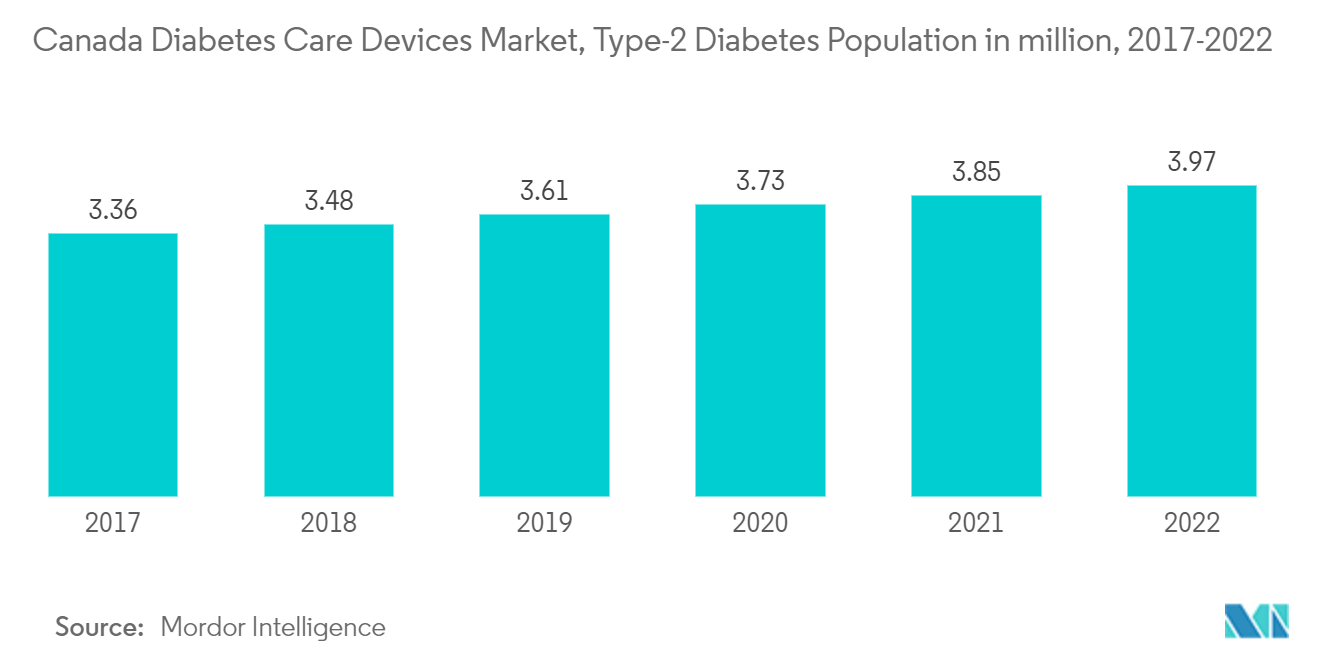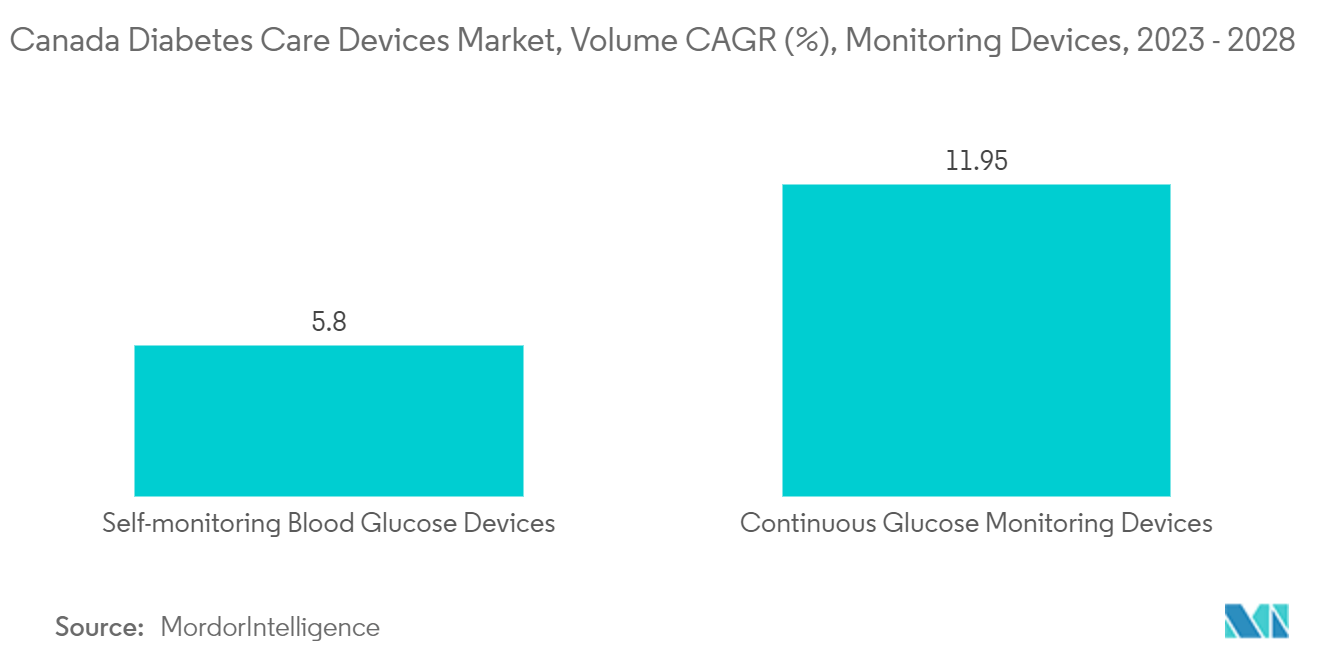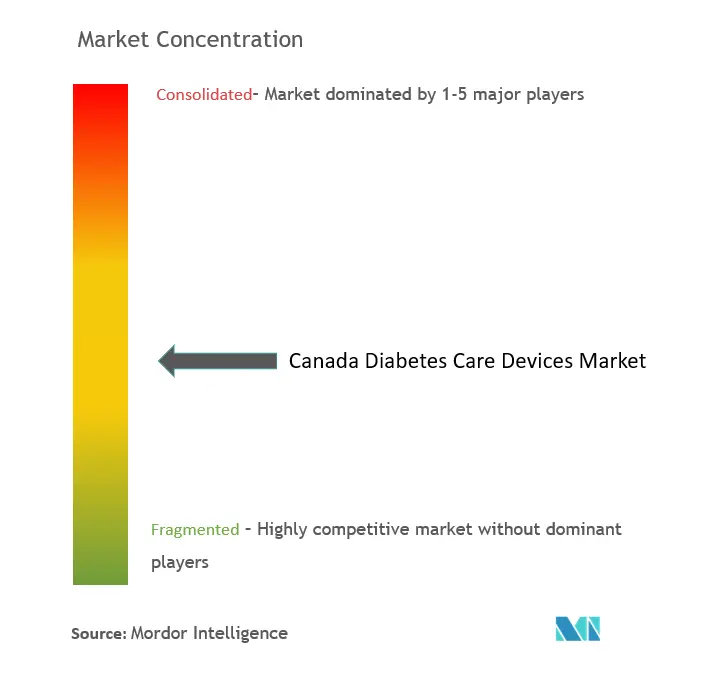Canada Diabetes Care Devices Market Size

| Study Period | 2018 - 2029 |
| Base Year For Estimation | 2023 |
| Forecast Data Period | 2024 - 2029 |
| Market Size (2024) | USD 1.93 Billion |
| Market Size (2029) | USD 2.47 Billion |
| CAGR (2024 - 2029) | 4.98 % |
Major Players
*Disclaimer: Major Players sorted in no particular order |
Need a report that reflects how COVID-19 has impacted this market and its growth?
Canada Diabetes Care Devices Market Analysis
The Canada Diabetes Care Devices Market size is estimated at USD 1.93 billion in 2024, and is expected to reach USD 2.47 billion by 2029, growing at a CAGR of 4.98% during the forecast period (2024-2029).
Canada has 107,861 cases of coronavirus disease 2019 (COVID-19) (286 per 1,00,000 individuals) and 8787 COVID-19-related fatalities as of July 13, 2020. In Canada, public health is overseen at the federal, provincial, and regional levels, and the Canadian constitution delegates healthcare authority to the country's ten provinces and three territories. As a result, similar to the United States, where individual states generally defined the COVID-19 response, Canadian provinces have mostly selected containment and mitigation plans. Provincial public health authorities collaborated closely with regional public health officers and municipal governments to develop policies and recommendations, as well as to put services like testing and contact tracing in place. Blood pressure regulation is a critical component of diabetes management. Furthermore, even in the absence of high blood pressure, certain blood pressure lowering medications are frequently recommended for people living with diabetes to protect them from kidney and heart-related complications. There is currently no scientific evidence linking these blood pressure drugs to the likelihood of COVID-19 infection or associated consequences.
In Canada, During the pandemic, many healthcare providers have adopted a hybrid model of care, offering certain types of visits in-person at the clinic and others virtually, by phone, video chat, or secure messaging. Virtual diabetes care may be a new and different experience for you. For tips on preparing for your diabetes visit and managing virtual appointments.
Canada Diabetes Care Devices Market Trends
Rising Diabetes Prevalence in Canada
The diabetes prevalence in Canada is expected to rise by about 2.7% over the forecast period.
In the current year, according to Diabetes Canada, more than 5.7 million Canadians are living with diagnosed diabetes (type 1 or type 2 diabetes). However, 11.7 million Canadians are living with diabetes or prediabetes, a condition that, if left unmanaged, can develop into type 2 diabetes. Diabetes is also costing the healthcare system USD 30 billion per year to treat people with diabetes.
Diabetes care can be most effective when combined with an education program that incorporates instruction for people with diabetes on healthy behavior changes in response to blood glucose values and for healthcare providers on how to adjust antihyperglycemic medications in response to blood glucose readings. As part of this education, people with diabetes should receive instruction on how and when to perform self-monitoring, record the results in an organized manner, the meaning of various blood glucose levels, and how behavior and actions affect blood glucose results.
The Canadian Diabetes Strategy is a national partnership that includes the provinces and territories, many national health organizations and interest groups, and Aboriginal communities nationwide. The purpose of the Canadian Diabetes Strategy is to articulate and establish effective diabetes prevention and control strategies for Canada. With access to its partners' collective knowledge and experience, the Canadian Diabetes Strategy is well-positioned to determine the needs and gaps and ensure that resources are deployed accordingly.
Therefore, the studied market is anticipated to grow over the analysis period due to rising prevalence and increasing awareness through government initiatives.

The Self-monitoring Blood Glucose Devices Segment holds the highest market share in the Canada Diabetes Care Devices Market in the current year
The Self-monitoring Blood Glucose Devices Segment holds the highest market share in the Canada Diabetes Care Devices Market in the current year. It is expected to account for the highest CAGR of about 7.1% in the market over the forecast period owing to the increasing glucometers adoption in home care settings, growing preference for home-based self-monitoring, and recent product launches of advanced glucometers.
Glucose monitoring gives people with diabetes a complete picture of their blood sugar levels, which can influence short and long-term treatment decisions and improve health outcomes. It allows them and their healthcare providers to assess the glycemic status and adverse effects and to determine the effectiveness of glucose-lowering therapies. Glucose monitoring can improve blood sugar management and quality of life for people with diabetes, resulting in physical, social, emotional, and functional benefits.
Capillary blood glucose monitoring or self-monitoring of blood glucose is one way for people with diabetes to measure and assess their glucose levels. It uses a drop of blood from a finger prick to get a blood glucose reading using a blood glucose meter or glucometer. Those with diabetes are advised to work with their care team to determine the frequency and pattern of testing. In Canada, Capillary blood glucose test strips cost, on average, USD 0.79 each. Reimbursement from the government for test strips is provided through provincial drug plans and is based on the prescribed course of treatment, age, and income.
The market players are adopting various strategies such as collaborations, partnerships, mergers, acquisitions, and expansions to increase market share. For instance, in May 2021, Roche Diabetes Care Canada announced a collaboration with Ellerca Health, a Toronto-based company dedicated to improving patient care through innovation and technology. The partnership included the launch of Accu-Chek and 360Care, combining Roche's Accu-Chek Guide blood glucose meter, customized home delivery of testing strips, and Ellerca's self-management digital program, 360Care. It empowers patients to control their treatment schedule with access to a team of health coaches.
Thus, the abovementioned factors are expected to drive the segment growth over the forecast period.

Canada Diabetes Care Devices Industry Overview
The Canada Diabetes Care Devices Market is moderately fragmented, with few significant and other generic players. Manufacturers like Abbott, LifeScan, F. Hoffmann-La Roche AG, Ascensia, etc., occupy a major share.
Canada Diabetes Care Devices Market Leaders
Dexcom
Medtronic
Novo Nordisk A/S
F. Hoffmann-La Roche AG
Abbott Diabetes Care
*Disclaimer: Major Players sorted in no particular order

Canada Diabetes Care Devices Market News
- July 2022: NuGen Medical Devices Inc. announced that its needle-free injection system and accessories, also known as InsuJet, were approved by Health Canada specifically for needle-free insulin delivery.
- March 2022: The Ontario government announced that it would provide coverage for the Dexcom G6 CGM System through Ontario's Assistive Devices Program (ADP) for people in the province with type 1 diabetes who are over 2 years of age and meet coverage criteria. The Non-Insured health benefits program also covers first nations and Inuit children. With expanded public coverage for CGM, more people can access this standard care technology, helping them to manage life-long chronic illnesses more effectively.
Canada Diabetes Care Devices Market Report - Table of Contents
1. INTRODUCTION
1.1 Study Assumptions and Market Definition
1.2 Scope of the Study
2. RESEARCH METHODOLOGY
3. EXECUTIVE SUMMARY
4. MARKET DYNAMICS
4.1 Market Overview
4.2 Market Drivers
4.3 Market Restraints
4.4 Porter's Five Forces Analysis
4.4.1 Bargaining Power of Suppliers
4.4.2 Bargaining Power of Consumers
4.4.3 Threat of New Entrants
4.4.4 Threat of Substitute Products and Services
4.4.5 Intensity of Competitive Rivalry
5. MARKET SEGMENTATION
5.1 Management Devices
5.1.1 Insulin Pump
5.1.1.1 Insulin Pump Device
5.1.1.2 Insulin Pump Reservoir
5.1.1.3 Infusion Set
5.1.2 Insulin Syringes
5.1.3 Insulin Disposable Pens
5.1.4 Insulin Cartridges in Reusable pens
5.1.5 Insulin Jet Injectors
5.2 Monitoring Devices
5.2.1 Self-monitoring Blood Glucose Devices
5.2.1.1 Glucometer Devices
5.2.1.2 Test Strips
5.2.1.3 Lancets
5.2.2 Continuous Glucose Monitoring
5.2.2.1 Sensors
5.2.2.2 Receivers (Receivers and Transmitters)
6. MARKET INDICATORS
6.1 Type 1 Diabetes Population
6.2 Type 2 Diabetes Population
7. COMPETITIVE LANDSCAPE
7.1 COMPANY PROFILES
7.1.1 Novo Nordisk A/S
7.1.2 Sanofi Aventis
7.1.3 Eli Lilly
7.1.4 F. Hoffmann-La Roche
7.1.5 Abbott Diabetes Care
7.1.6 Lifescan
7.1.7 Arkray
7.1.8 Ascensia Diabetes Care
7.1.9 AgaMatrix Inc.
7.1.10 Dexcom
7.1.11 Medtronic
7.1.12 Ypsomed Holding AG
7.1.13 Terumo
- *List Not Exhaustive
7.2 COMPANY SHARE ANALYSIS
7.2.1 Self-monitoring Blood Glucose Devices
7.2.1.1 Abbott Diabetes Care
7.2.1.2 F. Hoffmann-La Roche Ltd
7.2.1.3 Others
7.2.2 Continuous Glucose Monitoring Devices
7.2.2.1 Abbott Diabetes Care
7.2.2.2 Medtronic PLC
7.2.2.3 Dexcom
7.2.2.4 Others
7.2.3 Insulin Devices
7.2.3.1 Medtronic PLC
7.2.3.2 Novo Nordisk A/S
7.2.3.3 Others
8. MARKET OPPORTUNITIES AND FUTURE TRENDS
Canada Diabetes Care Devices Industry Segmentation
Diabetes care devices are the hardware, equipment, and software used by diabetes patients to regulate blood glucose levels, prevent diabetes complications, lessen the burden of diabetes, and enhance the quality of life. The Canada Diabetes Care Devices Market is segmented into management devices (insulin pumps, insulin syringes, disposable insulin pens, insulin cartridges in reusable pens, and insulin jet injectors) and monitoring devices (self-monitoring blood glucose (glucometer devices, test strips, and lancets) and continuous glucose monitoring (sensors and receivers (receivers and transmitters))). The report offers the value (in USD million) and volume (in units million) for the above segments.
| Management Devices | |||||
| |||||
| Insulin Syringes | |||||
| Insulin Disposable Pens | |||||
| Insulin Cartridges in Reusable pens | |||||
| Insulin Jet Injectors |
| Monitoring Devices | |||||
| |||||
|
Canada Diabetes Care Devices Market Research FAQs
How big is the Canada Diabetes Care Devices Market?
The Canada Diabetes Care Devices Market size is expected to reach USD 1.93 billion in 2024 and grow at a CAGR of 4.98% to reach USD 2.47 billion by 2029.
What is the current Canada Diabetes Care Devices Market size?
In 2024, the Canada Diabetes Care Devices Market size is expected to reach USD 1.93 billion.
Who are the key players in Canada Diabetes Care Devices Market?
Dexcom, Medtronic, Novo Nordisk A/S, F. Hoffmann-La Roche AG and Abbott Diabetes Care are the major companies operating in the Canada Diabetes Care Devices Market.
What years does this Canada Diabetes Care Devices Market cover, and what was the market size in 2023?
In 2023, the Canada Diabetes Care Devices Market size was estimated at USD 1.84 billion. The report covers the Canada Diabetes Care Devices Market historical market size for years: 2018, 2019, 2020, 2021, 2022 and 2023. The report also forecasts the Canada Diabetes Care Devices Market size for years: 2024, 2025, 2026, 2027, 2028 and 2029.
Canada Diabetes Care Devices Industry Report
Statistics for the 2024 Canada Diabetes Care Devices market share, size and revenue growth rate, created by Mordor Intelligence™ Industry Reports. Canada Diabetes Care Devices analysis includes a market forecast outlook to for 2024 to 2029) and historical overview. Get a sample of this industry analysis as a free report PDF download.
